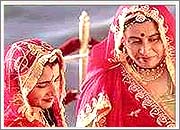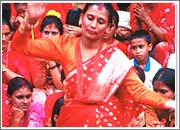Teej Festival
Introduction
 A
unique festival for women, Teej is primarily celebrated in
Rajasthan, Punjab, Haryana, parts of Uttar pradesh and Bihar. Teej
festival is dedicated to the re-union of Goddess Parvati with Lord
Shiva. Mostly celebrated among women, Teej festival is celebrated
for longevity and well-being of husband and children.
A
unique festival for women, Teej is primarily celebrated in
Rajasthan, Punjab, Haryana, parts of Uttar pradesh and Bihar. Teej
festival is dedicated to the re-union of Goddess Parvati with Lord
Shiva. Mostly celebrated among women, Teej festival is celebrated
for longevity and well-being of husband and children.
Long swings decorated with flowers, colorfully dressed young
girls and women, glittering jewellery, delicious feasts, tough
fasting, religious processions and songs & dance mark the gaiety of
Teej festival.
Teej festival is celebrated with much enthusiasm. Falling on the
onset of monsoon after a long season of oppresive heat, Teej
festival in India is also known as 'Sawan Festival'.
When is Teej Festival
Teej festival comes on the Hindu month of Shravan (July-August) and
also in early September. The dates of celebrating the festival
change every year according to the arrival of the monsoon. There are
three kinds of Teej festival :
Haryali Teej
Haryali Teej is celebrated on the beginning of Monsoon season.
Haryali means greenery, so Haryali Teej is associated with good
harvest and prosperity. On this day women dress up in green coloured
clothes. They worship the Moon, Lord Krishna and Goddess Radha.
Kajari Teej
Kajari Teej is celebrated on third day of the dark half (Krishna
Paksha) of Shravan month in Hindu Calendar. On this day women gather
to sing devotional songs and worship neem tree. Special procession
is also organised to worship the beautifully decorated idol of
Goddess Parvati.
Hartalika Teej
This form of Teej is the most important occasion during entire Teej
festival celebrations. Hartalika Teej lasts for three days and women
observe a fast on the second day that is called Nirjara Fast meaning
'fast without water'. Hartalika Teej fast is observed with great
devotion for the long life and prosperity of Husbands.
Legend of Teej
 The Spirit of Teej symbolises "ideal marriage" highlighting the
legend of Goddess Parvati uniting with Lord Shiva after a penance of
over hundred years. It is believed that Parvati's blessings lead to
marital bliss.
The Spirit of Teej symbolises "ideal marriage" highlighting the
legend of Goddess Parvati uniting with Lord Shiva after a penance of
over hundred years. It is believed that Parvati's blessings lead to
marital bliss.
Rituals of Teej
Idols of Goddess Paravati bedecked with new clothes, jewellery are
worshiped. After a ceremonial worship at home, elephants, camels and
horses are taken out in a ceremonial process.
Women undergo fast, sing folk songs and dance to express for Goddess
Parvati. It is a belief that fasting unmarried women will luckily
find a suitable husband. Fasting married women would find bond of
love with their husbands strengthened.
Celebration of Teej
During Teej, swing ropes on the courtyards decorated with flowers
are a common sight. Newly married girls return to their parents
home, receiving clothes from their parents and other male kins.
Rural women buy bangles, bindis, bead-necklaces and consume
mouth-watering dishes. Celebration includes games such as
turban-tying and bangle wearing competition.
Teej festival holds a significant place in the religious,
cultural, social and climatic life of Indians. It commemorates the
holy reunion of Goddes Parvati with her husband Lord Shiva. Teej is
celebrated to welcome the Monsoon season and is celebrated with lots
of enthusiasm and deep devotion. Teej festival also provides
strength to the bond of marital life.

 A
unique festival for women, Teej is primarily celebrated in
Rajasthan, Punjab, Haryana, parts of Uttar pradesh and Bihar. Teej
festival is dedicated to the re-union of Goddess Parvati with Lord
Shiva. Mostly celebrated among women, Teej festival is celebrated
for longevity and well-being of husband and children.
A
unique festival for women, Teej is primarily celebrated in
Rajasthan, Punjab, Haryana, parts of Uttar pradesh and Bihar. Teej
festival is dedicated to the re-union of Goddess Parvati with Lord
Shiva. Mostly celebrated among women, Teej festival is celebrated
for longevity and well-being of husband and children.  The Spirit of Teej symbolises "ideal marriage" highlighting the
legend of Goddess Parvati uniting with Lord Shiva after a penance of
over hundred years. It is believed that Parvati's blessings lead to
marital bliss.
The Spirit of Teej symbolises "ideal marriage" highlighting the
legend of Goddess Parvati uniting with Lord Shiva after a penance of
over hundred years. It is believed that Parvati's blessings lead to
marital bliss.